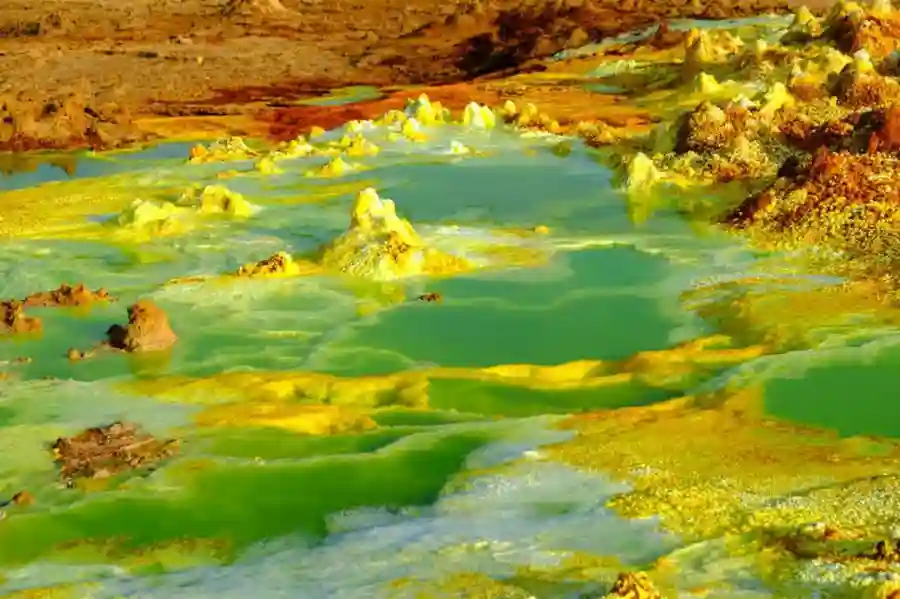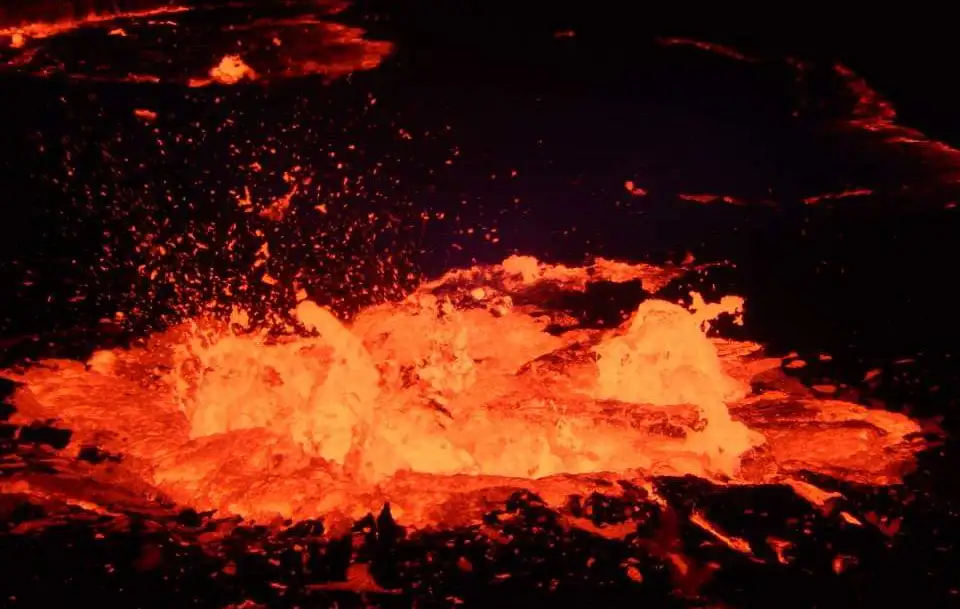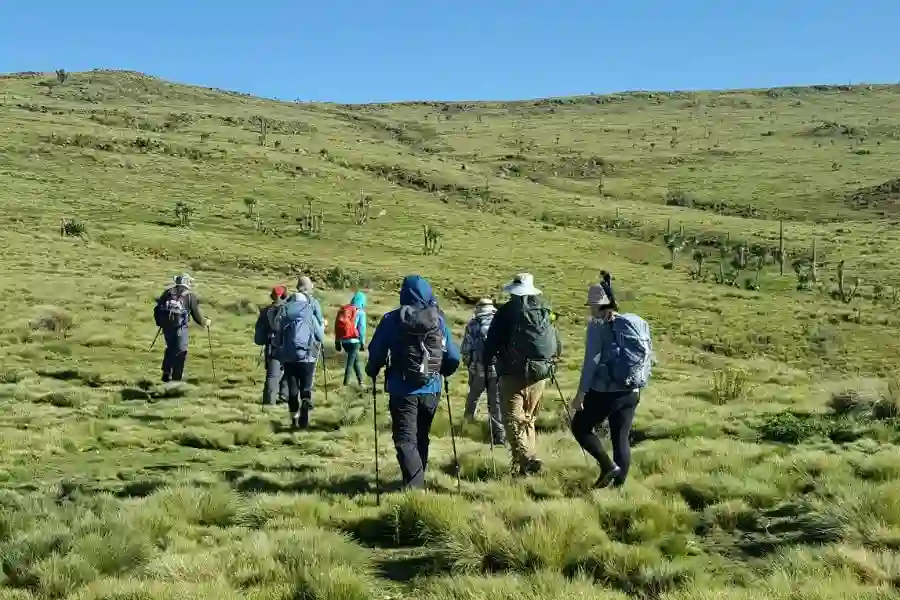Simien Mountains Trekking and Tours
Historic North Circuit Trekking & Volcano Tours – 18 Days
tour itinerary
Historic North Circuit Trekking & Volcano Tours – 18 Days
Fusing history, culture, landscapes and wildlife along a perfectly paced circuit, this trip is a synthesis of the very best experiences on offer in Ethiopia’s northern highlands. Explorations of the ancient cities Axum, Gondar, Bahir Dar and Lalibela are broken up by hikes in the Simien Mountains National Park,Combine this with a visit to the rock churches of Gheralta, discover the alien landscapes of Dallol, the bubbling lava lakes of Erta Ale, and watch the sun go down over Lake Afrera.
The following sample itinerary is based on using internal flights from Ethiopian Airlines and local guides / services in each location. This keeps the overall cost down and saves on some long and arduous journeys. If preferred we can quote to include an accompanying tour leader for the whole trip and / or overland travel by 4wd instead of internal flights.
Day 1
Evening arrival in Addis
Upon arrival at Bole International Airport, your driver will meet you outside the airport terminal and transfer you to your hotel. Activities depend on international flight arrival time.
Overnight Addis Ababa
Accommodation: Hotel or Lodge
Day 2
Addis Ababa
Spend the day exploring the bustling capital city of Addis Abeba . Visit the key sites of your choice, and enjoy dinner at one of the capital’s fantastic cultural restaurants.
Overnight Addis Ababa
Accommodation: Hotel or Lodge
Day 3
Bahir Dar
Today you’ll head out on a boat trip onto Lake Tana, Ethiopia’s largest lake which is dotted with more than 30 islands, many of which house churches and monasteries. Take a boat trip over the lake to Zege Peninsula to visit two of the renowned Island Monasteries: Ura Kidane Mihret and Azua Mariam, both of which have wonderful paintings depicting scenes from the Old and the New Testaments of the Holy Bible.
The architectural style of Ura is a typical example of the Ethiopian Orthodox Church, with mud plastered round walls and a conical thatched roof. Ura is known especially for its fine frescoes, manuscripts, ecclesiastical objects like crown of various emperors dated from the 14th century, processional crosses of silver & gold, silver-drum and royal vestments.
Later in the afternoon, you’ll visit the market, where you can find the typical hand-woven capes and scarves made of good, local cotton. Visit Weyto village, 2km west of town, known for its production of Tankwa boats. Lastly, you’ll encounter the Palace of the Emperor Haile Selassie at Bizeit, with great views of the town and the lake, including where the Blue Nile flows out of the lake.
Overnight: Bahir Dar
Accommodation: Hotel or Lodge
Day 4
Bahir Dar – Gondar
After breakfast in Bahir Dar , transfer to Gondar. Spend a few hours exploring this wonderful city.
Gondar was the home of Kings and Queens of Ethiopia for about two centuries. The city was the first capital of the Ethiopian empire that began in 1632 with the reign of Fasilidas.
Today there lies the castle ruins, the majority of which lie in the Royal Enclosure, a fairy-tale like castle compound dating back to the 17th century. The castles reflect the glory of Gondarine kings and have a characteristic lime mortar style.
Visit Debre Birhan Selassie church, rewarding for its magnificent murals adorning the roof and the walls of the church. Like many Eastern Orthodox churches, Debre Birhan has an unassuming stone-and-brick exterior with double-arched entrance door and two-tiered thatched roof. Once you enter, angels shine on you with light and colour. The interior walls and ceiling are fully covered by painted images of angels with big eyes and the walls depict biblical scenes and saints.
Visit the famous Fasilida’s pool, in which pilgrims still take a plunge at the issue of Timket (Epiphany) celebrations. It’s a beautiful and peaceful spot, where snakelike tree roots digest sections of the stone walls. Although the complex was used for swimming, it has also been used for religious celebrations, the likes of which still go on today. Once a year, it’s filled with water for the Timket celebration. After the water is blessed by a high priest, the pool becomes a riot of splashing water, shouts and laughter as a crowd of hundreds jumps in. The ceremony replicates Christ’s baptism in the Jordan River and is seen as an important renewal of faith. Nearby is a small mausoleum said to have been built for the king’s favorite horse.
Overnight: Gondar
Accommodation: Hotel or Lodge
Day 5
Drive (2.5 hrs) Gondar- Michibiny (3200 m), hike to Sankaber (3250 m)
From Gondar, we drive to Michibiny with a brief stop at the Simien Mountains National Park headquarters to arrange the permit. We start the trekking easy with a 2-3 hours hike to Sankaber, a good way to acclimatize and get used to the altitude.
Overnight Sankaber
Accommodation:camping.
Day 6
Hike Sankaber to Gich (3600 m).
Today’s trek covers a distance of approximately 12 km and takes around 5-6 hours. The hike goes through highland grasslands, heather forests, cultivated fields and follows a spectacular escarpment with dramatic views.
We will encounter the friendly Gelada baboons, foraging in big groups. A stunning viewpoint at the Jinbar Falls is reached after clambering a few rocks. This waterfall plunges several hundred meters down the escarpment down into the abyss.
At the end of the day we pass through the welcoming village of Gich where the local people are happy to prepare a well-deserved coffee. The coffee ceremony is an important social event in Ethiopian culture. The camp for the night is not far from the village. Overnight Geech
Accommodation: Camping.
Day 7
Hike Gich to Chennek (3620 m).
This is a long but probably the most spectacular stage of the trekking, offering stunning views all the way.
Today we hike 7-8 hours to cover 12 km, including a short detour to Imet Gogo (3925 m). This summit offers the most exciting views. The giant lobelia is abundant on the Gich plateau. The majestic lammergeyer might soar the skies in front of you and the endemic thick billed raven will be present.
On your way to Chennek you pass some other major peaks (Inataye reaching 4070 meter) and a deep valley. Chennek is the best place to spot the endemic and endangered Walia Ibex. Not seldom they walk into the camp.
Overnight Chennek
Accommodation: Camping.
Day 8
Hike Chennek to Ras Bwahit (4430 m). Drive (3 hrs) to Debark .
The last day in the Simien Mountains takes us up to the Bwahit Pass (4200 m) and if you’ve got the energy, you can hike all the way to Ras Bwahit, the second highest peak of Ethiopia after Ras Dashen. Total hike is 10 km, 5-6 hrs. Not only will you likely spot the Walia Ibex, you might even spot the endemic, and extremely rare, Ethiopian Wolf. In the late afternoon, we drive back to Debark for Overnight.
Accommodation: Hotel or Lodge
Day 9
Axum
Leave Debark behind and drive down the switch backs to Axum. It’s a relatively long drive (6 hours or so), but passes through stunning scenery. There will be plenty of stops along the way to stretch your legs and soak up the views!
Explore the city of Axum. Visit the archaeological sites, the towering obelisks, the tombs that employed massive stone architecture and the obelisk field to the west of the town. Also see the compound of Tsion Mariam, the remains of the ancient church and old Sabean stones that are scattered in the compound. The chapel of the Ark of the Covenant is here along with the more modern and Gonderine churches.
Overnight Axum
Accommodation: Hotel or Lodge
Day 10
Hawzien
You trip ends with a bang. Two nights at the stunning Korkor Lodge in Tigray.
After lunch at the lodge, explore some of the rock-churches in the region. The rock churches of Tigray are astounding not just for their history, rock carvings and paintings, but also for their representation of the religious commitment of the local people. Built high into the cliff face, some of these churches are only accessible through climbing the vertical cliff, and yet they’re still used by local Ethiopians of all ages. The views from inside the churches is extraordinary. The view as the sun sets behind the mountains and the sky illuminates in dark reds, yellows and oranges is the perfect end to your adventure.
Overnight Hawzien
Accommodation: Hotel or Lodge
Day 11
Hawzien
Another full day exploring the beautiful landscapes and churches around Korkor Lodge, or simply relaxing and enjoying the view from your veranda.
Overnight Hawzien
Accommodation: Hotel or Lodge
Day 12
Danakil Depression
After breakfast in the lodge, we begin our excursion into the incredible Danakil Depression. A geological depression caused by the continental drift of three tectonic plates, the Danakil Depression is one of Earth’s most unusual environments. Renowned as the ‘hottest place on the planet’ and home to salt lakes, lava lakes, volcanoes, and colourful acidic springs – it’s a wonderful, alien environment.
We meet the rest of the group and jump into the reliable Toyota Landcruisers that will be our safe haven as we journey into one of the most inhospitable places on the planet. Stop for lunch at Kusrawat, before pressing on to Dodom, the basecamp at the base of the Erta Ale volcano.
Have dinner with your group around 6PM and prepare to being the hike up the volcano at around 7PM when the sun dips towards the horizon. The hike up Erta Ale takes about 3 hours across a gentle inclination of rocky terrain. The terrain itself is not challenging, but the heat of the region combined with the duration of the trek (3 hours) can make it challenging for some travellers.
We’ll arrive at the crater rim around midnight. The lava lake at Erta Ale is among the most stunning natural phenomena anywhere in the world. The bubbling magma cuts through the crusted charcoal surface like laser beams as smoke bellows from this ‘gateway to hell’.
Spend the night at nearby campsite on the volcano. Stones and rocks demarcate ‘rooms’ that fit up to 3 people, and camels transport mattresses and blankets to the top of the volcano.
Activities: Drive to Danakil Depression, Hike Erta Ale
Overnight:Erta Ale
Accommodation:Camping on the volcano
Enjoy a relaxed morning around the lodge before beginning the drive to Negele, a great birding spot within the Rift Valley.
Overnight Negele
Accommodation: Hotel or Lodge
Day 13
Erta Ale to Hamed Ela
Rise early (5AM) and return to crater rim for one last look into the fiery caldera before beginning the 3 hour descent back to Dodom. Upon arrival at Dodom, enjoy breakfast before piling back into the Landcruisers.
Drive through the Danakil desert across the sprawling salt pans where you’ll find local Afar people working under the searing heat to cut the salt into blocks before loading onto camels. The camels are led back to nearby towns in ‘camel caravans’ as they transport the salt for export across the country. It’s a humbling site, and walking alongside these camel caravans in this distant corner of the world brings new appreciation to this ancient trade.
Arrive at the sparse settlement of Hamed Ela where your cooking team will once again do you proud. Enjoy refreshments and spend the evening under the stars on makeshift beds in the Danakil.
Activities: Drive through Danakil desert, witness salt mining and walk with camel caravans
Overnight: Hamed Ela Settlement
Accommodation: Camping
Day 14
Dallol and Salt Lakes
Your final day in Ethiopia may be the most extraordinary of all as we head to the incredible Dallol volcano, visit Lake Karum and swim in Lake Afrera and its nearby hot springs.
Dallol is a cinder cone volcano in the Danakil Depression, although its unique geology means it lacks any of the archetypal volcanic looks. Instead, Dallol is a canvas of bright green, reds, and yellows distributed across hundreds of hot acidic springs and mounds of salt deposits. Characterised by bright, multi-coloured springs, fissures, and geysers, and with average annual temperatures of 35°C (95°F), Dallol is one of the most visually compelling and geologically fascinating destinations on Earth. The landscape looks completely otherworldly.
Lakes Karum and Afrera are the two hyper-saline lakes in the Danakil Depression. Lake Karum (also known as Lake Asale) is one of the most visually striking lakes any in the world looking more looks more like an Arctic desert than a saline lake. The lake-bed is a jet white salt crust chequered in irregular contours that slowly becomes submerged in the clear water of Lake Karum. The transition from the salt pan to Salt Lake is so gradual that it feels as if the salt pan simply starts to shimmer and shine as it juts off into the horizon.
Lake Afrera sits over 100m below sea level in the Danakil Depression, and contains the world’s lowest lying island, known as Deset. At the horizon, dormant volcanoes protrude out from Afrera’s shimmering green topology, and Afrera’s extreme salt concentration results in mounds of salt building up on the lakes shores. Unlike Lake Karum, Lake Afrera can be swam in, and its hypersaline nature leaves you floating weightlessly. It’s a refreshing respite on your journey in the Danakil, and there are nearby freshwater hot springs that make for natural jacuzzis to wash the salt off before jumping back into the air-conditioned Landcruisers.
As your exploration of the Danakil draws to a close, we drive back to Mekele for overnight.
Accommodation: Hotel or Lodge
Day 15
Drive Mekele to Lalibela
After breakfast at the lodge, transfer to Lalibela. This is a full day drive that passes through a number of villages and beautiful landscapes. There’ll be plenty of stops along the way for photo opportunities and breaks.
Evening at leisure in Lalibela.
Overnight Lalibela
Accommodation: Hotel or Lodge
Day 16
Lalibela
Spend the day exploring the fascinating town of Lalibela, home to the world-renowned rock-hewn churches. A UNESCO World Heritage site, these churches date back to the 13th Century and earlier, and have often been called the ‘eight wonder of the world’.
The churches are found in three clusters. Two main clusters are separated by the Jordon River, and the stunning Biete Giyorgis (Church of St George) stands alone to the west. The local guides are often priests who run daily services in the churches.
After exploring the churches, spend your final night in Ethiopia at leisure. We recommend a night at the incredible Ben Abeba restaurant – dinner with a view!
Day 17
Explore Remote Churches of Lalibela
Today is an opportunity to take it a little slower. you can choose to walk or ride a rented mule (small extra cost for the mule) up to Asheton Maryam Church, situated at about 3100 metres. Here you will be rewarded with spectacular views of Lalibela town and the surrounding valleys.
Day 18
Return
You’ll be transferred back to Lalibela airport for your return flight to Addis. Most have a long afternoon in Addis before a late evening flight home, so we will provide a driver and vehicle for the afternoon. Suggested activities for the afternoon .
tour
Pricing
Price will depend on your final itinerary, group size, accommodation choices, and time of year.























